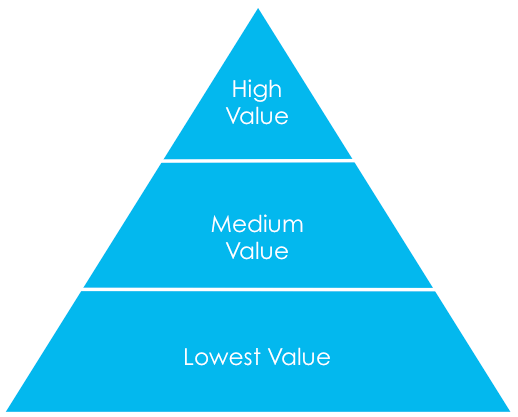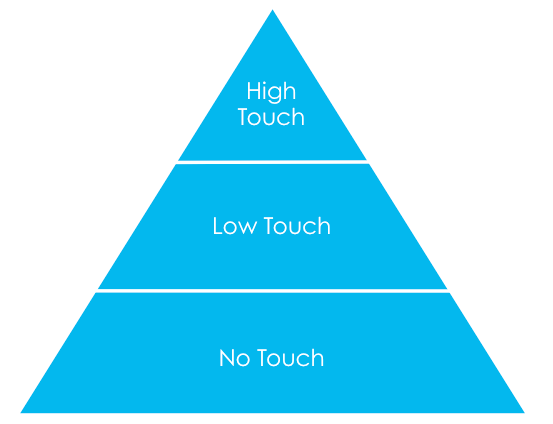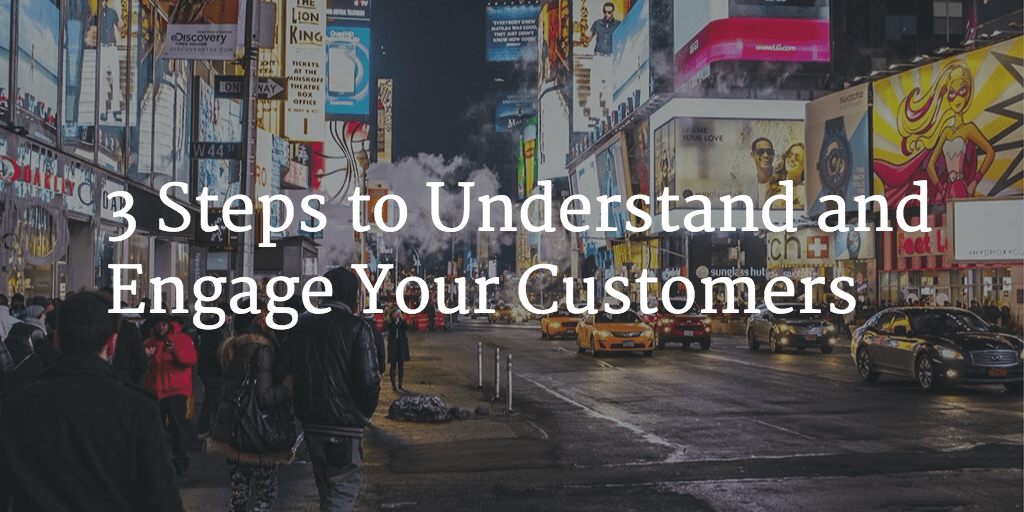It is impossible to understand and engage your customers in a one-size-fits-all fashion if you have more than a handful of customers.
You’ve probably been told – or told others – something like this: “Here are your 150 customers, now go understand them and get engaged.”
Yikes! Okay, so I’ve done this a thousand times and it still scares me to think about it.
That’s why there has to be a logical approach to it. So, let’s try to create one.
Step 1 – Segment your Customers
Depending upon the maturity of – or your involvement with – your Customer Success Management organization, some of this may have already been done. If so, it’s likely to be clearly defined in your CRM system.
Or, your company may have already segmented customers as Strategic or National or Global or Enterprise or Corporate for sales purposes – which gives you a head start, In fact, there may also be a “touch model” (more on that later) defined. A word of caution, though… how customers were segmented for sales purposes may not translate 100% to what we’re solving for here, so be sure to get clear on the segmentation that was used and adjust accordingly.
And of course, if neither of these have been done or you want to understand or refine the process, keep reading. In fact, keep reading either way.
There are literally a million ways to segment customers so let’s talk first about why you want to do this. In Customer Success, the reason for segmentation is to define the relative value of each customer and, ultimately, to define your engagement/touch model.
There are at least two different reasons for segmenting your customers. One is for value (which ones are most important to your company). The second is what we call cohorts.
Cohorts are simply groupings of customers who are similar in some way (purchase date, industry, size, geography, products). With a Customer Success application like Gainsight, cohorts just become a way of slicing the data and are valuable and easy to manipulate and analyze.
Here are some of the criteria that are often used to define those:
- Contract Value – for many companies, this is the first (and even only) criteria for segmentation. Simply done, this could just be a ranking from highest to lowest of how much each customer is paying you.
- Customer Size – this can also be referred to as “white space”. It’s simply an attempt to define the size of the overall opportunity at each customer. For example, if you sell an Engineering tool and have sold 100 licenses to Intel, there would clearly be a very large opportunity for expansion.
- Industry – it may be that all industries are not created equally for you. Your solution might be a perfect fit for technology companies but you are trying hard to break into Financial Services. This may mean that any existing Financial Services customers have a higher value than your technology customers.
- Brand – this is simply placing a higher value on customers with a very high brand recognition. So the companies with the best names in your industry, are the most valuable.
- Referencability – your best customer references are obviously really important and valuable to you. It’s logical to place a higher specific value on them for the purpose of segmentation.
There are lots of other attributes that might drive your segmentation, too. You’ll probably not want to make this too complex because you’ll need to explain it to the rest of your company, and you want new customers to logically fit into one of a relatively small number of segments (3 or 4).
Once you decide on your segment attributes, you’ll want to think about the number, and definition, of your segments. Three or four segments is probably the right number and, if you create a scoring model as suggested above, you can easily break your customers into those groups.
Think about your customer base as a pyramid:

At the top of the pyramid are a small set of very high value customers. If you were using only contract value, you might define that segment as those customers who make up 50% of your company’s Annual Recurring Revenue (ARR).
Most likely, that will be 10% of your overall install base or less.
Okay, so we have the segments, now…
Step 2 – Create an Engagement Model
Now let’s talk about your engagement/touch model because it will help you define your segments more clearly. Simply put, your engagement model describes how, and how often, you will touch your customers.
If we go back to the top of the customer pyramid, it’s obvious that you would want to touch those customers more often, and in different ways, than you will the customers in the lowest section of your pyramid.

Here are some possible engagements with those high-value customers:
- On-site visits
- Quarterly Business Reviews
- Annual Health Checks
- Monthly Best Practices meetings
It’s probably becoming clear at this point, that your value segmentation is closely tied to the engagement model and that’s what drives your headcount needs.
For example, if you define an engagement model for your most valuable customers that requires 200 hours/year of interaction with each of them and you know that you can only dedicate three headcount to that segment, you will need to draw the lines between segments such that only about 25 customers fall into that top segment.
In general then, your engagement and segmentation models together will help you identify exactly how many people you will need to cover your install base.
As an individual CSM, you may want to refine this model for your own book of business so you can effectively communicate with your manager, how much time you are spending with each of your customers and where the gaps are between what he/she expects (or what you’d like to do) and reality. There will never be enough time to do everything you’d like.
Segments and Engagement Models are important, but…
Step 3 – Prioritization is Key!
Once the segmentation and engagement models are outlined, your engagement with your customers will be driven by one of three things:
- Pre-planned, proactive engagement (like Quarterly Business Reviews or QBRs)
- Ad-hoc, proactive engagement (random calls to customers or data-driven outreach)
- Reactive engagement (customer has issues and needs help)
At this point, it’s all about prioritization. Even after segmentation is complete, you’ll have plenty of situations where your list of customers to reach out to is long and many of them are in the same segment.
In this case, the order of touch is often defined by two simple numbers: ARR and Renewal Date.
If you are in a company that does not do renewals (i.e. month-to-month contracts that “auto-renew”), then the second element of prioritization may be “least recently touched”. In other words, who haven’t you talked to in the longest time?
Customer Engagement Styles and Methods
No one can tell you how to talk to your customers because every single situation is going to be unique. No doubt you will figure out the right combination of product and domain expertise that will make you invaluable to your customers.
But there are two other key elements of your engagement with customers that will make a big difference – preparation and follow-up.
Unless you are just in the wrong job, your skills will bring value to your customers so your direct interactions with them will be good. But you want them to be very good, not just good. And the way to do that is to be as prepared as possible for each interaction and then to be diligent in your follow-up.
That’s simple common sense to be sure, but you will find yourself surprised at what a difference it makes to your customers – and to your boss when he is evaluating you relative to your peers. It’s really no different than Sales where the IQ difference between great Sales people and average ones is not significant.
Nor is their ability to articulate their value proposition and influence customers in the favored direction. What sets the great ones apart is the way they prepare and the quality of their follow-up. The same is true for you. Make them the bookends of your customer engagements.
The best way to ensure you have high-performing Customer Success Managers that fully understand how they fit into the Customer Journey is to enroll them in Customer Success University now.


